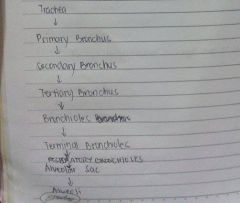![]()
![]()
![]()
Use LEFT and RIGHT arrow keys to navigate between flashcards;
Use UP and DOWN arrow keys to flip the card;
H to show hint;
A reads text to speech;
24 Cards in this Set
- Front
- Back
|
Upper Respiratory System |
Nose, Pharynx and Associate Structures (Nasal Cavity, Oral Cavity) |
|
|
Lower Respiratory System |
Larynx, Trachea, Bronchi, Lungs |
|
|
portion visible on face |
Nose |
|
|
- starts at internal nares and extend to cricoid cartilage of larynx - passageway of air and food - resonating chamber - houses tonsils |
Pharynx |
|
|
closes of during swallowing |
Epiglottis |
|
|
pair of folds of mucuos membranes, vocal folds |
Glottis |
|
|
Division of Bronchi |
Carina |
|
|
extend from larynx to superior border of T5 |
Trachea |
|
|
right & left primary bronchus goes to the right lung |
Bronchi |
|
|
separated from each other by the heart and other structures in the mediastinum |
Lungs |
|
|
each lung divides by 1 or 2 fissures |
Lobes |
|
|
How many orders of branching |
25 |
|
|
cup-shaped outpouching |
Alveoli |
|
|
2 or more alveoli sharing a common opening |
Alveoli Sac |
|
|
4 actions of ribs |
- piston action - pump handle - bucket handle - caliper action |
|
|
How many segments are there in the lungs (left & right) |
18 segments |
|
|
How many segments are needed in the lungs |
7 segments |
|
|
How many generations |
23 generations |
|
|
the generation where reflex happens |
7th generation |
|
|
What to avoid when doing CPR |
Cyphoid Process |
|
|
main site of gas exchange |
Type I Alveolar Cells |
|
|
secretion of alveolar fluid (type of alveolar epithelial cells) |
Type II Alveolar Cells |
|
|
Respiration Steps |
- Pulmonary Breathing - Internal Respiration - External Respiration |
|
|
Branching of Bronchial Tree |

|

